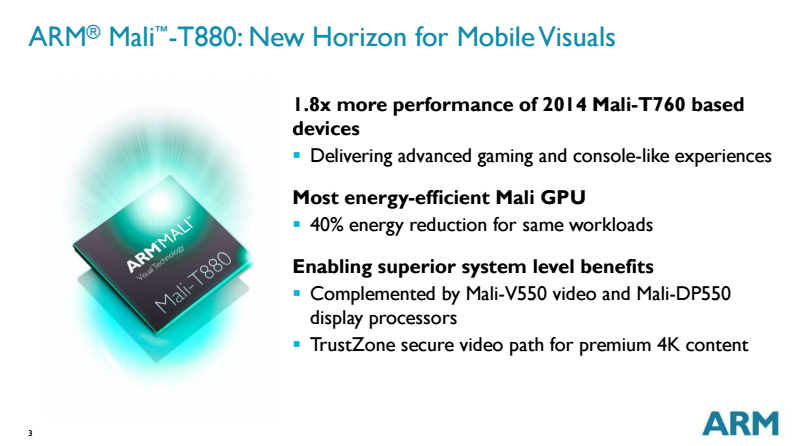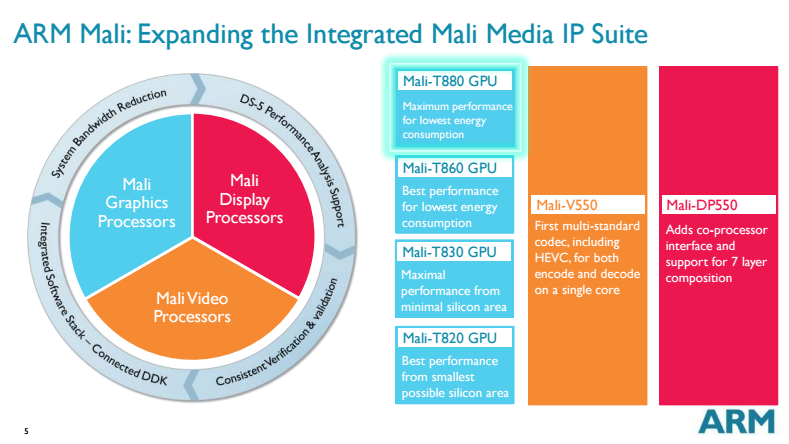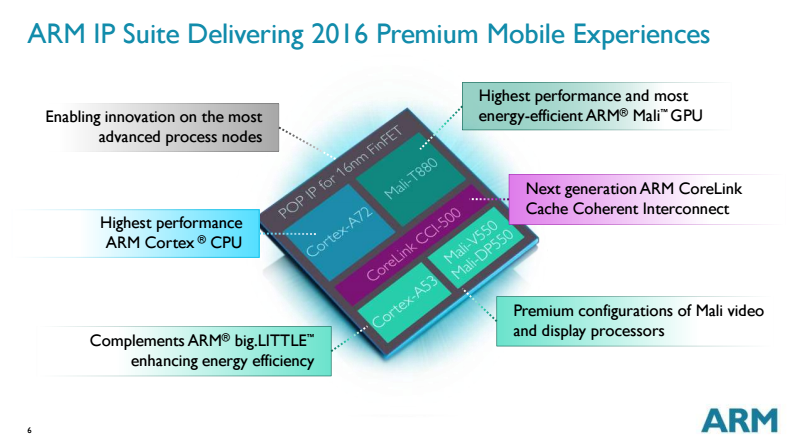ARM's Mali-T880 GPU To Be 80 Percent Faster Than Mali-T760, Arrives In 2016
ARM hasn't been in the GPU IP market for long. It acquired Falanx, a GPU IP designer, less than 10 years ago (2006), after it was previously sub-licensing GPU IP from Imagination. Since then, ARM's Mali graphics IP has seen steady growth, and ARM is now the GPU IP leader in both the Android market (Apple only uses Imagination GPUs for iOS devices anyway) and in digital TVs market.
ARM's Mali GPU shipped in 550 million devices in 2014, which is 150 million more than in the previous year. It also gained 27 new licensees in 2014, totaling 110 Mali licensees.
ARM has managed to keep its customers happy by continuing to introduce competitive GPU IP. The latest introduction is the Mali-T880 GPU, which will be one level above the Mali-T860, which is in turn the Mali-T760 successor. The Mali-T760 was first seen in the Galaxy Note 4 (international Exynos version), so its successor, the Mali-T860, will likely arrive in the Galaxy Note 5, while the Mali-T880 will probably arrive in Galaxy S7.
The new Mali-T880 will be 80 percent faster compared to the Mali-T760, if power consumption remains at the same levels. If the performance is kept at the same level instead, then the GPU would consume 40 percent less power.
It will be up to chip makers such as Samsung to decide the best compromise between an increase in performance and a decrease in power consumption, but usually chip makers decide to keep the power consumption the same and go all-in with the performance increase. It's also one of the reasons why new smartphones don't seem to be dramatically better in battery life, despite having bigger batteries every year.
There is a new trend in making smartphones much thinner, such as the iPhone 6 or the Galaxy Alpha. These devices tend to have significantly smaller batteries, too. That leads OEMs to want to use more efficient processors, rather than chips that are much more powerful. However, the more efficient chips are only used to compensate for the smaller batteries, so the ultra-thin devices shouldn't get better battery life on average.
The Mali-T880 is highly configurable, and OEMs can use as many as 16 cores, which is up from eight for the Mali-T760 but the same maximum number of cores that the the Mali-T860 will have, as well. The Mali-T880 can also be complemented by ARM's other IP products such as the Mali-V550 video processor and the Mali-DP550 display processor, which can help deliver 4k video.
Get Tom's Hardware's best news and in-depth reviews, straight to your inbox.
ARM's high-end product IP suite for 2016 will include the Cortex-A53 CPU core; the Cortex-A72 CPU core, which at 16nm FinFET can deliver three times the performance of the original 28nm Cortex A15; the Mali-T880 GPU, Mali-V550 and Mali-DP550 for media acceleration; and the next-generation CoreLink CCI-500 cache coherent interconnect that ties everything together.
Follow us @tomshardware, on Facebook and on Google+.
Lucian Armasu is a Contributing Writer for Tom's Hardware US. He covers software news and the issues surrounding privacy and security.
-
Vlad Rose 2016 is a long ways away still. I'm sure the competition will have at least the same as well. Heck, Intel may even be knocking on their power/performance door by that point.Reply -
InvalidError Reply
If you look at it the other way, 80% more next year is about twice the performance improvement relative to last year's model.15307339 said:2016 is a long ways away still. I'm sure the competition will have at least the same as well. Heck, Intel may even be knocking on their power/performance door by that point.
If the K1's modest sales are any indication, very few people and device manufacturers are interested in high-end mobile graphics if it means sacrificing battery life, so SoC designers are not showing any signs of suffering from having IGPs only about half as fast.
Intel "catching up" on IGP is likely not much of a concern. Even if Intel had a world-leading IGP, they would still need to convince mobile device designers to switch over to x86, something Intel has been struggling with for years. -
aldaia Reply2016 is a long ways away still. I'm sure the competition will have at least the same as well. Heck, Intel may even be knocking on their power/performance door by that point.
Actually ARM has small direct competition on the market. I can only think of Imagination technologies and Vivante Corporation as direct competitors of ARM in the IP GPU arena.
ARM is a Semiconductor IP company, that sells its IP to anyone designing chips/socs. Contrary to popular belief, Intel, Nvidia, Apple etc ... are not ARM´s competitors. Those companies either sell chips or final consumer products, not IP. ARM only sells IP blocks. And they seem to do very well in that area. -
InvalidError Reply
Last time I checked, all you need to have competition is multiple companies or products with overlapping target markets for a given type of product or service, directly or indirectly. While ARM is leaving manufacturing to their licensees, their licensed products do end up in SoCs that compete directly against other SoCs which use a different architecture for the CPU, GPU or both. Intel's Atom is certainly competing against all things ARM for mobile market share - or at least trying to with moderate success.15311894 said:Contrary to popular belief, Intel, Nvidia, Apple etc ... are not ARM´s competitors.
-
Vlad Rose Reply15311894 said:ARM is a Semiconductor IP company, that sells its IP to anyone designing chips/socs. Contrary to popular belief, Intel, Nvidia, Apple etc ... are not ARM´s competitors.
If that was the case, then AMD wouldn't be considered a competitor to Intel since Intel licenses out the x86 IP to them.
The Mali GPU is only used only in certain lines of ARM chips. While you mentioned Vivante (not sure who uses it) and Imagination technologies (PowerVR used by Apple), there's also Qualcomm's Adreno, Nvidia's Tegra, and Broadcom's VideoCore; among others.
http://en.wikipedia.org/wiki/Mali_(GPU) -
aldaia ReplyIf that was the case, then AMD wouldn't be considered a competitor to Intel since Intel licenses out the x86 IP to them.
The Mali GPU is only used only in certain lines of ARM chips. While you mentioned Vivante (not sure who uses it) and Imagination technologies (PowerVR used by Apple), there's also Qualcomm's Adreno, Nvidia's Tegra, and Broadcom's VideoCore; among others.
http://en.wikipedia.org/wiki/Mali_(GPU)
Intel doesn't license it's IP blocks to AMD. AMD only has an ISA license, but has to design its own processors (implementing x86). That is not the case with ARM that sells fluull processor blocks or in that case a GPU block for other to use in their own socs.
Vivante GPUs are used by Rockchip, Marvell and Freescale among others. Adreno is only used by qualcomm, tegra GPU's only by Nvidia and Videocore by Broadcom. No one uses those IP blocks outside the proprietary company. On the other hand the list of companies that use Mali is significantly large.
The business model of ARM is characteristic in the sense that contrary to Intel, AMD, QualcomM or Nvidia, ARM doesn't sell chips they only sell IP blocks to other companies (that are the ones that design and sell the SOcs)
-
somebodyspecial Reply15308570 said:
If the K1's modest sales are any indication, very few people and device manufacturers are interested in high-end mobile graphics if it means sacrificing battery life, so SoC designers are not showing any signs of suffering from having IGPs only about half as fast.15307339 said:2016 is a long ways away still. I'm sure the competition will have at least the same as well. Heck, Intel may even be knocking on their power/performance door by that point.
That will end though as GPU power grows and we all realize we're holding xbox360+ in our hands and the devs know there are 1.5B of them to shoot at (and growing yearly, upgraded yearly). The hardware has to be there before they'll take their shots. See GDC for the last two years and how they avoid xbox1/ps4 until 10mil+ are in the wild (nintendo has the same issue, they HAVE to make their own games, because nobody else is at under 10mil). This is why they already shifted heavily to mobile. By the time a game ships that you start now, everyone will have 14/10nm in their pocket with at worst (probably) K1 (kepler) or maybe even maxwell level gpu power, assuming a 1-1.5yr game making process. Even a year from now maybe sony has 25mil and xbox1 has 20mil. I'd still be developing for the 1.5B aiming at that same xmas audience this year (and all the upgrades they get from xmas phones, tablets etc). The same can be said of 64bit REAL apps. Next year when power is amped and we're mostly sporting 4GB+ mem in the phone, larger storage, a polished 64bit OS etc, you can start making PC like apps on ARM to be used when plugging in at home to a monitor/key/mouse as a PC replacement for poor people, kids etc. ARM (and it's allies) are coming for the PC, it's just a matter of time and when they put out a 75-100w soc model with a PC like fan/heatsink and all other components that go with that.
Wintel is rightfully worried ;) Thus Intel is losing 4B on mobile trying to stop it, and MS is seen giving away mobile OS's (or really cheap lics vs. old ~80 price of them), offering free win10's to some people etc. They have no choice, but I think they are way to late and let ARM etc get far to entrenched to stop it all. It's just a matter of how much does each side own in 5-10yrs? It will now be ARM (armada so to speak) vs. Wintel, not Intel vs. AMD. Thank god, because AMD isn't keeping Intel prices down, ARM is along with all the free OS options over there. Hopefully a new gpu competitor will emerge from mobile side too & again to replace what seems to be an AMD behind in gpu for good probably now.
I just hope they aren't going to all be sued and lose before that game gets going. I'm not sure any of them can get out of NV IP and legally make a gpu, and hopefully AMD IP would win something too if that is the case. That may be the saving grace of AMD if NV wins and a few are then sued by AMD too. That is, assuming they have some great gpu IP too after all these years that is probably being stolen if so. Nv has 7000+ gpu patents, but not sure about AMD's gpu side. They just can't afford to start the suit until they see how NV's turns out. I hope AMD lives until it's over. It would be best if NV had to go to trial instead of companies settling with them (which provides no case for AMD to work from). AMD would then have a bundle of info to point to from NV's trial and save them a ton of lawyer work/cost. But who knows how this works out for now. We'll know more this summer I guess.



